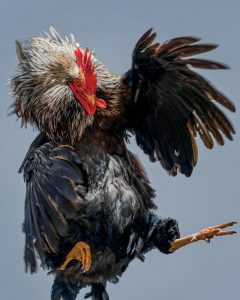Plague Journal, Photography & Violence
Photography has been an interest for many years. In high school I began taking my fathers Kodak box camera to the drag strip. Imagine using a camera with a 1/30th second shutter speed and 100 ASA film to record the accelerating launch of a dragster. My first lesson: a photograph depends essentially upon the adaptability of the photographer. Everything else is subsidiary.
I was intrigued upon discovering an essay on photography in the last issue of the NY Times Style Magazine. The piece entitled, The Brutal Truth, was an interview with Heiji Shin, a photographer with a reputation for doing courageous work.
 Here is illustrative photo from the article, one of a series of photos recently shown at Galerie Buchholz in Berlin. This series was entitled “Big Cocks.” Viewing this image, what feelings arise to awareness for you? After several moments of patient observation do you have any thoughts about beauty and power?
Here is illustrative photo from the article, one of a series of photos recently shown at Galerie Buchholz in Berlin. This series was entitled “Big Cocks.” Viewing this image, what feelings arise to awareness for you? After several moments of patient observation do you have any thoughts about beauty and power?
Finally, a sample quotation from the Times article written by Megan O’Grady.
“To create is always a step into the unknown,” she says. “Everything has to submit to art. Everything. When you’re an artist, you have to submit politics to your art. Not the other way around. You have to submit your own emotions, your anxieties, your ideologies. That’s why art is this really kind of sacred thing. And to do it the other way around always compromises certain things, right?” — Heiji Shin
To read the entire article, CLICK HERE.
Finally some photographs taken just yesterday. The first five were taken in the back yard. Flower blossoms, translucent, gossamer, lasting only a few days, and a view of petite fungus growing in decaying humus, transformation of decomposing detritus into new life. The white Buddha completes the series.
The last few photos were taken at Washington Park in Ottowa, Illinois. The monument memorializes those who served in the Union Army from La Salle county, and especially the war dead. The tall marble column was erected in 1872 just a few years after the war’s end in 1865. The names engraved into the marble column are indecipherable, effaced by remorseless time. Washington Park also was the site of the first Lincoln Douglas debate (1858) which is memorialized by a fountain, and renderings of Lincoln and Douglas in bronze.
Our parks are typically used to celebrate war, using marble, granite, and bronze to remember “for eternity” men erased from the living by the ravenous god of war, — until the next war. This strikes me as quite insane. Wouldn’t we rather remember other things for eternity? We can do better. We must do better.
War has a “long tail.” The casualties continue for years afterward, suicides precipitated by “shell shock,” or in our current usage, PTSD. The last photo of the series reminded me of this reality: the zip-tied card displaying the contact number for a suicide help line.









2 thoughts on “Plague Journal, Photography & Violence”
Having served, during the Vietnam War, I believe that parks that honor the dead may be a way to relieve the living that somehow there was a noble cause worth the price, but knowing that there is another war always on the horizion. Greed, ambition, and ego are great justification for those who lead in absentia.
“Lead in absentia”… wondering how that would work?